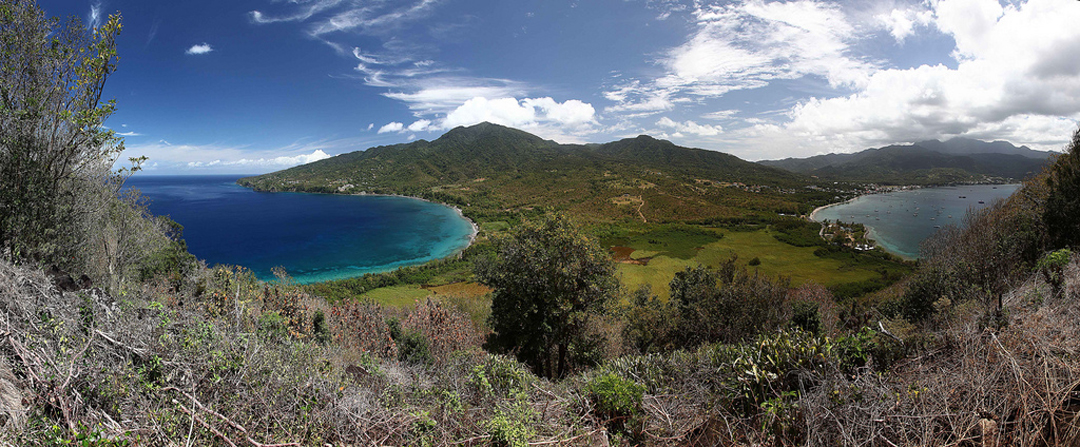Report on Morne aux Diables (Dominica) — March 2013
Bulletin of the Global Volcanism Network, vol. 38, no. 3 (March 2013)
Managing Editor: Richard Wunderman.
Morne aux Diables (Dominica) Earthquake swarm began in mid-2009
Please cite this report as:
Global Volcanism Program, 2013. Report on Morne aux Diables (Dominica) (Wunderman, R., ed.). Bulletin of the Global Volcanism Network, 38:3. Smithsonian Institution. https://doi.org/10.5479/si.GVP.BGVN201303-360080
Morne aux Diables
Dominica
15.612°N, 61.43°W; summit elev. 861 m
All times are local (unless otherwise noted)
Morne aux Diables is the northermost of the nine volcanic centers on the island of Dominica (Lindsay and others, 2005) (figure 1). The complex (figures 2 and 3) is comprised of five intact andesitic crystal rich lava domes that form a central depression. Within the depression, a 'Cold Soufrière' is evident with hydrothermally altered rocks and many small bubbling pools. No historical eruptions are known, although the volcano has a youthful appearance, and activity at flank domes likely continued into the late Pleistocene and Holocene (Lindsay and others, 2005). Robert Watts, at the University of the West Indies (UWI) Seismic Research Centre, reported that the volcano remains quiet, though with noteworthy seismicity in 2009 and 2010.
Watts, and Lindsay and others (2005), reported that in 2002 SeaBeam bathymetry highlighted a double peaked lava dome (known informally as Twin Peaks) on the sea floor a few kilometers off the northern coastline of Dominica. The summit of the higher dome (at 15.671?N, 61.476?W) was 153 m below sea level. This northern coastline terminating the N end of the Morne aux Diables complex forms a linear cliff that may represent a fault.
Seismic swarm during 2009-2010. The most common area of seismicity, as noted by Watts and others (2012a and 2012b), has been in the SE sector of Dominica. In the north there were spurts in activity in 1841, 1893, 2000, and a particularly intense week-long burst of more than 500 earthquakes in 2003. Following six years of low-level activity, a nearly continuous series of earthquakes was recorded beneath the central area of Morne aux Diables beginning in June 2009. The seismic swarm continued through at least 2010 with variations in activity that are consistent with volcano-tectonic (VT) activity.
The VT series reached a peak in December 2009, with many events felt by villagers on the flanks of the volcano, but earthquake activity afterwards gradually been diminishing. Beginning in December 2010, VT earthquakes exhibited a gradual shallowing with time (a few approaching 1 km depth), indicating that they are related to a vertical re adjustment of the stresses below the volcano, most likely caused by magma movement (Watts and others, 2012b).
References. Lindsay, J.M., Smith, A.L., Roobol, M.J., and Stasiuk, M.V., 2005, Dominica in Lindsay, J.M., Robertson, R.E.A., Shepherd, J.B. and Ali, S. (eds), Volcanic Hazard Atlas of the Lesser Antilles, Seismic Research Centre, The University of the West Indies, Trinidad & Tobago, West Indies, p. 1-48.
Roobol, M.J., and Smith, A.L., 2004a. Volcanology of Saba and St. Eustatius, northern Lesser Antilles, Amsterdam: Royal Netherlands Academy of Arts and Letters, 320 p.
Roobol, M.J., and Smith, A.L., 2004b, Geologic map of Dominica, West Indies (URL: http://www.caribbeanvolcanoes.com/dominica/content/dominicamap.pdf).
Watts, R.B., Robertson, R.E., Abraham, W., Cole, P., de Roche, T., Edwards, S., Higgins, M., Johnson, M., Joseph, E.P., Latchman, J., Lynch, L., Nisha, N., Ramsingh, C., and Stewart, R.C., 2012a , Elevated seismic activity beneath the slumbering Morne aux Diables volcano, Northern Dominica and the monitoring role of the Seismic Research Center, poster presentation at the 2012 American Geophyhsical Union Fall Meeting, San Francisco, CA.
Watts, R., Robertson, R., Abraham, W., Cole, P., Corriette, D., de Roche, T., Edwards, S., Higgins, M., Issacs, N., Johnson, M., Joseph, E., Latchman, J., Lynch, L., Nisha, N., Phillip, B., Ramsingh, C., and Stewart, R., 2012b, Elevated seismic activity beneath the slumbering Morne aux Diables volcano, northern Dominica, poster on UWISRC web (URL: http://www.uwiseismic.com/Downloads/Dominica_activity_Poster_Watts.pdf).
Geological Summary. The lava dome complex of Morne aux Diables (Devils' Peak) forms the northern tip of the island of Dominica. Several nested craters and a 90-m-high, 335-m-wide lava dome are located within a larger 1.2-km-wide crater. The complex overall includes seven andesitic lava domes with a central depression where a cold soufriere is located. A chain of lava domes, two of which form a peninsula on the SW flank, form an E-W belt across the S flank. Bathymetry shows a double-peaked lava dome (known informally as Twin Peaks) off the northern coast, truncated by a 4-km-long fault-bounded cliff. No eruptions are known in historical time, although the volcano has a youthful appearance and activity at flank domes likely continued into the late-Pleistocene and Holocene. The youngest (NW) summit crater contains an active thermal area with bubbling springs. Severe earthquake swarms in 1841 and 1893 were associated with either Morne aux Diables or Morne Diablotins to the south. Shallow volcano-tectonic seismicity was detected as recently as February 2010.
Information Contacts: Robert B. Watts, The University of the West Indies (UWI) Seismic Research Centre, St. Augustine, Trinidad & Tobago, West Indies (URL: http://www.uwiseismic.com/).




